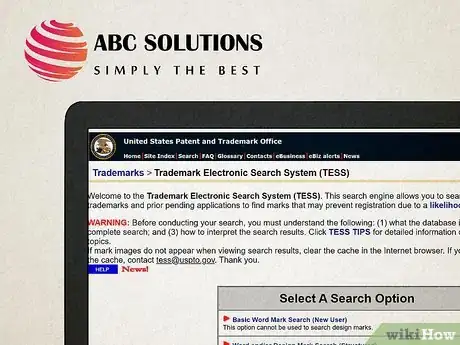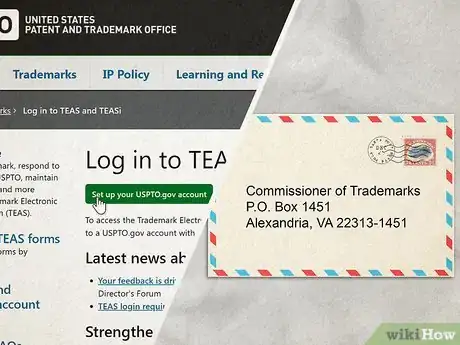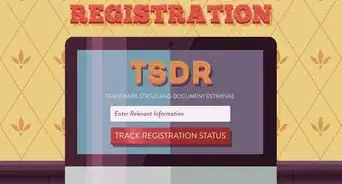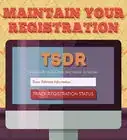This article was co-authored by Madison Boehm. Madison Boehm is a Business Advisor and the Co-Founder of Jaxson Maximus, a men’s salon and custom clothiers based in southern Florida. She specializes in business development, operations, and finance. Additionally, she has experience in the salon, clothing, and retail sectors. Madison holds a BBA in Entrepreneurship and Marketing from The University of Houston.
wikiHow marks an article as reader-approved once it receives enough positive feedback. In this case, 100% of readers who voted found the article helpful, earning it our reader-approved status.
This article has been viewed 153,351 times.
Your logo is part of your brand to identify your business as the source of your goods and services. It's important to protect that brand, and by extension, the logo that represents it. One way to do this is to register your logo with the United States Patent and Trademark Office (USPTO) as a trademark, although US registration is completely optional. How to register a logo as a federal trademark is explained in the steps below.
Steps
-
1Determine that your logo is distinctive within your field. You will not be allowed to register a trademark for a logo similar to one that's already registered in the USPTO in any related field. You also should not use a logo that is similar to any already in use on goods or services in your field. You need a "clearance search" to minimize the legal risks of using or trying to register something similar to other trademarks.[1]
- It is recommended that you hire a trademark attorney to help you complete the clearance search.[2] Adoption of a logo that is deemed too similar to another logo will put you at risk of copyright or trademark infringement and it be rejected for registration. You may be forced to start over with a different logo if you find out too late that yours will result in a conflict.
- Start by searching the USPTO's online database for existing trademarks that may be similar to your logo. Although registration is optional, many valuable brands are now or formerly registered and the initial search results may help you to understand how closely your brand compares with existing or expired registrations or applications.
- The USPTO's online database is the Trademark Electronic Search System (TESS). Searches are free, but you'll need to consult the Design Code Search Manual for the codes for any relevant design elements for comparison with existing designs.
- The USPTO's Public Search Library is also free. It is located in Alexandria, VA and open weekdays from 8:00 a.m. to 5:30 p.m. The USPTO also maintains regional Patent and Trademark Depository libraries with CD-ROM databases, but these databases do not include design mark images.
- You should also search relevant registration databases for states in which you operate or distribute your goods or services. Trade journals and catalogs for your field may also prove valuable for determination of whether similar brands are already in use, whether or not registered.
-
2Evaluate existing trademarks you find for possible conflicts. If you find existing registered logos that look similar to your design, the TESS display will provide the application serial number, registration number, current status and links to the Trademark Status and Document Retrieval (TSDR) database.
- Use the TSDR links to see whether those registrations are still in effect or why they were rejected or cancelled. If none of their registrations are currently in force, and you have not found any similar brands in use or registered elsewhere, you can proceed to apply to register your logo.
- The TSDR database is updated daily at 5 a.m., so check after 5 a.m. for the most current updates. Furthermore, the TSDR database contains important information that is not found on the search website, its Gazette, or its informational CD-ROM.[3]
Advertisement -
3Prepare a trademark application.[4] You'll need to prepare a written description of your logo and the goods and services to which it will be applied. (The USPTO's Acceptable Identification of Goods and Services Manual provides guidance on how to write a description of your goods or services.) You'll also have to create a drawing of your logo using the USPTO's specified size and format.
- An application may contain claims for registration of the logo in one or more classifications of goods or services, or you may submit separate applications for each class. Fees are required for each class. Details about the classification system can be found at the USPTO trademark website.
- You will also need to submit a "specimen" showing how your logo is in actual use on the described goods or services in U.S. commerce. Examples include a photograph of the logo on a product, or a screen-shot of the logo used to advertise your services.
- If you have not yet used your logo on goods in commerce, you may still file an "ITU" application, if you certify that you have an "intent to use" the logo as described. This gives you the option of three or more years in which to get your products or services into the market with the logo, before your application will be rejected for non-use. Additional fees will apply for finalizing an ITU application.
- Applications for US registration of brands already registered in other countries have slightly different rules, which you will need to discuss with your trademark attorney.
-
4File the application with the USPTO. Once you have cleared your logo for use, you can simply begin using your logo, or register in one or more states in order to gain limited rights.[5] However, the way to gain more extensive rights nationwide is to file with the U.S. Patent and Trademark Office. There are several ways you can file:
- Use the Trademark Electronic Application System (TEAS) to draft and submit your application online. TEAS provides the ability to check your application for completeness before submitting, then provides an e-mail summary of your application and a serial number with which to track it (via TESS or TSDR).
- Send it by mail to the Commissioner of Trademarks, P.O. Box 1451, Alexandria, VA 22313-1451. Two to three weeks after you send it in, you'll receive a filing receipt and serial number.
- Deliver it by hand or courier to the Trademark Assistance Center, Madison East, Concourse Level Room C 55, at 600 Dulany Street in Alexandria. You will be given a time-stamped receipt with an application serial number.
-
5Follow up on your application. Check the status of your application on the TSDR database. Normally, you'll hear back from the USPTO in 3 to 4 months, but it sometimes may take longer.[6]
- The USPTO will have an examining attorney review your application, within about three months, and complete their own searches of various databases for potential conflicts. The examination results in either an "office action" or approval for publication.
- If there are any deficiencies in your application you will receive an "office action" from the examiner and will be given a limited time (up to six months) in which to address the issues.[7] Some problems cannot be repaired and you will have to abandon your application and start over. Your trademark attorney has experience avoiding such problems and can advise you accordingly.
- Some applications become the subject of lengthy amendments, arguments and appeals, and you will need to decide for yourself whether the registration is worth the added cost and delay.
- Once your application passes the initial examination for eligibility, after a few months it will be published in the weekly Trademark Official Gazette. If no opposition is filed within 30 days of the publication, your application will either be registered or else "allowed", pending completion of the ITU filings, if necessary.
- For an ITU application that has been allowed, there is a limited time in which to file proof of actual use in commerce. Petitions for extensions beyond the first six months will incur additional fees.
- After your registration is issued, you may apply the circle-R ® device to your logo, signifying federal registration.
- Going forward, you will have to file additional documents and pay additional fees to keep it in good standing after five years. Renewals will also become due every 10 years, assuming you continue to believe the registration is valuable.
-
6Set up a "trademark watch" service to safeguard your essential rights. A trademark watch is a service by a lawyer or organization, to monitor public uses of your logo and guard against someone else infringing on your trademark. These individuals or organizations will help you choose whether to file cease and desist letters or even put in motion trademark infringement lawsuits if your trademark is used unlawfully by others.
- You should also implement your own internal guidelines and monitoring processes to make sure your employees use the logo properly.
Expert Q&A
-
QuestionIs it worth it to trademark a logo?
 Madison BoehmMadison Boehm is a Business Advisor and the Co-Founder of Jaxson Maximus, a men’s salon and custom clothiers based in southern Florida. She specializes in business development, operations, and finance. Additionally, she has experience in the salon, clothing, and retail sectors. Madison holds a BBA in Entrepreneurship and Marketing from The University of Houston.
Madison BoehmMadison Boehm is a Business Advisor and the Co-Founder of Jaxson Maximus, a men’s salon and custom clothiers based in southern Florida. She specializes in business development, operations, and finance. Additionally, she has experience in the salon, clothing, and retail sectors. Madison holds a BBA in Entrepreneurship and Marketing from The University of Houston.
Business Advisor, Jaxson Maximus Absolutely! Your logo is part of your brand's identity and adds an intangible value to your business. With a trademark, you don't have to worry about random competitors trying to steal your name, either.
Absolutely! Your logo is part of your brand's identity and adds an intangible value to your business. With a trademark, you don't have to worry about random competitors trying to steal your name, either. -
QuestionCan I add more categories to my trademark?
 Madison BoehmMadison Boehm is a Business Advisor and the Co-Founder of Jaxson Maximus, a men’s salon and custom clothiers based in southern Florida. She specializes in business development, operations, and finance. Additionally, she has experience in the salon, clothing, and retail sectors. Madison holds a BBA in Entrepreneurship and Marketing from The University of Houston.
Madison BoehmMadison Boehm is a Business Advisor and the Co-Founder of Jaxson Maximus, a men’s salon and custom clothiers based in southern Florida. She specializes in business development, operations, and finance. Additionally, she has experience in the salon, clothing, and retail sectors. Madison holds a BBA in Entrepreneurship and Marketing from The University of Houston.
Business Advisor, Jaxson Maximus You definitely can, but each category requires a separate submission process. An examining attorney will review your application and either approve or deny it (with a provided explanation). If it's denied, you might have to resubmit your application.
You definitely can, but each category requires a separate submission process. An examining attorney will review your application and either approve or deny it (with a provided explanation). If it's denied, you might have to resubmit your application. -
QuestionHow much does it cost to get a trademark?
 Community AnswerProvided that you are selling your goods at the time of the trademark filing, your total cost of registering a trademark will be the flat legal fee of $950 and government filing fee of $275 per class.
Community AnswerProvided that you are selling your goods at the time of the trademark filing, your total cost of registering a trademark will be the flat legal fee of $950 and government filing fee of $275 per class.
Warnings
- Once the USPTO approves your logo as a trademark, you need to use it or lose your registration. You must also file regular documents with the USPTO to maintain your logo's status as a registered trademark.⧼thumbs_response⧽
- Do not send a cease and desist letter unless your research shows that your rights are superior to those of the person you are challenging. They may sue you immediately, if you're wrong.⧼thumbs_response⧽
References
- ↑ Madison Boehm. Business Advisor, Jaxson Maximus. Expert Interview. 24 August 2021.
- ↑ Madison Boehm. Business Advisor, Jaxson Maximus. Expert Interview. 24 August 2021.
- ↑ http://www.uspto.gov/products/library/ptdl/services/tmsearch.jsp
- ↑ Madison Boehm. Business Advisor, Jaxson Maximus. Expert Interview. 24 August 2021.
- ↑ http://justcreative.com/2011/01/17/how-to-trademark-a-logo/
- ↑ Madison Boehm. Business Advisor, Jaxson Maximus. Expert Interview. 24 August 2021.
- ↑ Madison Boehm. Business Advisor, Jaxson Maximus. Expert Interview. 24 August 2021.
- http://www.uspto.gov/trademarks/basics/howtofile.jsp
- http://www.uspto.gov/trademarks/basics/next.jsp
About This Article
To trademark a logo, start by searching the United States Patent and Trademark Office's database for any existing trademarks that are similar to your logo. If there's a logo that looks similar to the one you want to trademark, you'll need to come up with a different one. If there aren't any similar logos, submit an online application through the Trademark Electronic Application System. Alternatively, you can submit a paper application to the Commissioner of Trademarks. For advice on how to follow up on your application, scroll down!

























































